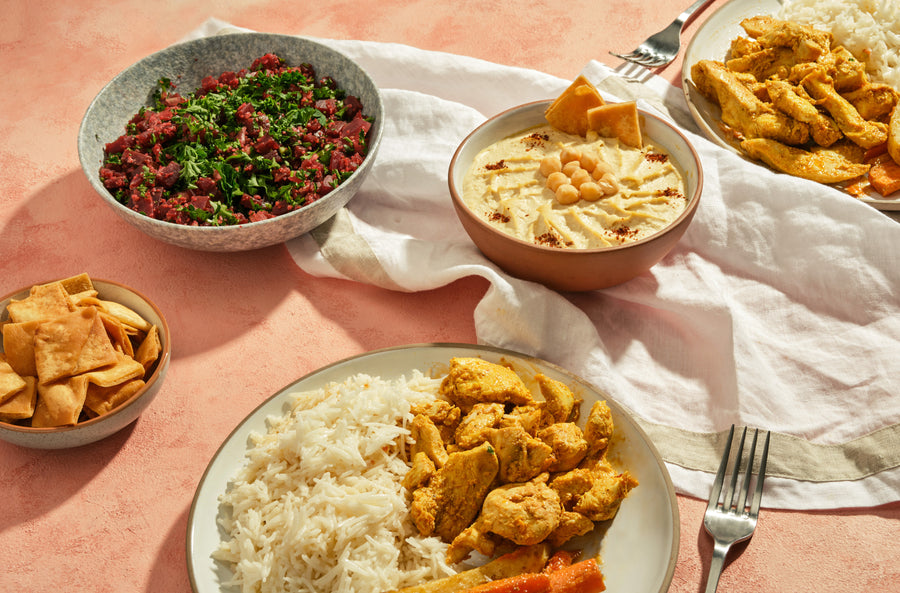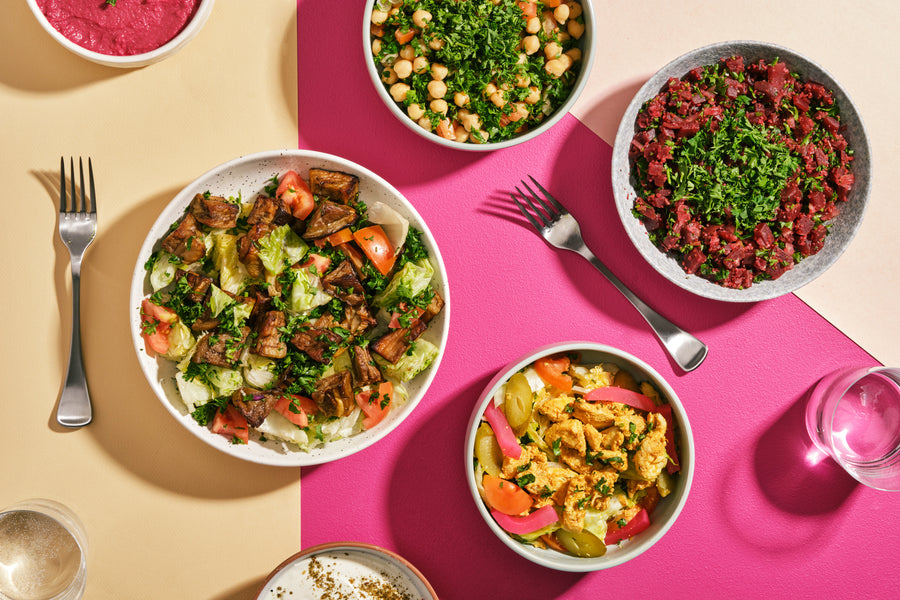All About the Rich Flavors and Traditions of Syrian Cuisine: A Culinary Trip
Syrian food offers a distinct mix of flavors and practices that reflect its abundant cultural background. With staple components like olive oil and garlic, together with a variety of seasonings, the dishes are both varied and welcoming. From the complex prep work of kibbeh to the pleasant attraction of baklava, each aspect of this cooking landscape discloses deeper stories. As one explores the significance of these flavors, a higher understanding of communal dining and event arises.
The Significance of Syrian Ingredients
The essence of Syrian active ingredients hinges on their rich variety and ingrained social importance. Influenced by the nation's different location and history, Syrian cuisine includes a large selection of spices, natural herbs, and fresh fruit and vegetables. Staples such as olive oil, garlic, and lemon supply a structure, while flavors like cumin, sumac, and coriander add deepness and complexity to dishes.The use of fresh herbs, consisting of parsley and mint, highlights the relevance of seasonal active ingredients. Additionally, the region's fertile dirt yields an abundance of veggies and fruits, such as pomegranates, eggplants, and tomatoes, which are essential to lots of dishes. Grains like bulgur and rice develop the base of many meals, emphasizing the importance of these components in Syrian society. This mix of tastes shows not just a cooking tradition but also a tapestry of historical influences, making Syrian components essential to comprehending its cuisine's vibrant character.

Iconic Dishes of Syrian Cuisine
Syrian food is renowned for its renowned dishes that showcase a rich tapestry of structures and flavors. Standard meze plates supply a selection of tiny dishes that entice the taste buds, while hearty main dishes give enjoyable focal points for meals (Afternoon Tea Vancouver). To finish the experience, a selection of delicious treats adds a wonderful note to the cooking journey
Traditional Meze Plates

Hearty Main Courses
Hearty main dishes function as the centerpiece of Syrian eating, showcasing a mix of flavors that reflect the country's abundant culinary traditions. Meals such as kebab hindi, featuring seasoned lamb skewers, and the renowned mujaddara, a reassuring mix of lentils and rice, highlight using fresh ingredients and fragrant spices. An additional staple is the famous kibbeh, made from bulgur wheat and minced meat, often offered in numerous forms, including baked, fried, or raw. Additionally, the tastes of the land come alive in dishes like packed vegetables, called mahshi, which are loaded with rice, meat, and herbs. These main courses not just satisfy appetite yet likewise inform tales of family members gatherings and cultural heritage.
Savory Treats Option
A fascinating range of desserts defines the sweet side of Syrian food, providing an alluring end to any dish. Amongst the most celebrated confections are baklava, fragile layers of phyllo bread full of nuts and saturated in syrup, and maamoul, shortbread-like cookies commonly stuffed with days or nuts. Knafeh, an abundant dessert made from thin noodle-like pastry soaked in syrup and layered with cheese, is a preferred option, specifically during festive celebrations. In addition, the wonderful and aromatic rice dessert, referred to as roz bil laban, provides a calming surface. These mouth-watering treats not just showcase the region's culinary expertise however additionally show the cultural heritage of Syria, making them treasured treats in both restaurants and homes alike.
Typical Cooking Techniques
Modern comforts have influenced many culinary methods, standard cooking strategies continue to be essential to Syrian food. These approaches often highlight using fresh, seasonal components and focus on sluggish food preparation to create abundant flavors. Methods such as barbecuing, braising, and stewing are prevalent, allowing the natural preferences of the components to beam through.One notable strategy is the preparation of kibbeh, a dish made from finely ground meat and bulgur. It needs experienced hand-rolling into various shapes and can be baked, fried, or served raw. Furthermore, the art of making bread, specifically pita, is main to several meals, often prepared in a conventional stone oven.Preservation methods like pickling and fermenting also play an essential duty, improving the diversity of tastes found in Syrian recipes. These methods not just mirror the region's agricultural heritage yet also cultivate a solid sense of area with shared culinary practices.

The Role of Spices in Flavor
Flavors act as the heart beat of Syrian food, instilling meals with intricate tastes and aromatic depth. Each seasoning plays a pivotal role, contributing not just to preference but additionally to the social heritage of the area. Frequently utilized seasonings consist of sumac, cumin, and coriander, each using an unique profile that boosts typical dishes. Cumin gives warmth and earthiness, while sumac adds an appetizing brightness, boosting the total dish.Syrian cooks frequently mix flavors to develop unified profiles, showing the elaborate balance of tastes that define the food. Using spices is not simply for flavoring; it likewise offers to protect food and boost its dietary value. This thoughtful incorporation highlights a deep understanding of the cooking arts, where spices become necessary authors, sharing the rich history and varied influences that define Syrian gastronomy. Ultimately, seasonings are important in crafting authentic and memorable Syrian dishes.
Joyful customizeds and celebratory meals
Celebratory meals in Syrian cuisine are useful source marked by traditional feast recipes that show the country's rich cooking heritage. Unique events frequently involve special rituals that boost the communal experience of eating. These customizeds not just honor the significance of the occasions however additionally reinforce domestic and social bonds.
Conventional Banquet Dishes
When family members collect to celebrate significant occasions in Syria, traditional feast recipes take facility phase, showcasing the abundant cooking heritage of the region. These events typically feature dynamic platters of mezze, including hummus, baba ghanoush, and tabbouleh, which act as wonderful beginners. The main dish typically highlights lamb or chicken, marinaded and prepared to excellence, usually accompanied by aromatic rice pilaf or bulgur. Among the most cherished meals is maqlooba, a split rice dish with veggies and meat, flipped inverted before serving. Sugary foods also play an essential duty, with baklava and knafeh supplying a pleasant surface to the meal. Each recipe not just delights the taste yet additionally shows the deep-rooted traditions and communal spirit of Syrian society.
Special Occasion Rituals
Special celebrations in Syria are marked by rich rituals that link food and festivity, mirroring the social value of public celebrations. Commemorative meals often include standard dishes such as kibbeh, tabbouleh, and different smoked meats, prepared with treatment and shared amongst family and friends. Throughout spiritual vacations like Eid al-Fitr and Eid al-Adha, households collaborated to prepare special sweets like maamoul, symbolizing unity and happiness. Wedding events are particularly intricate, featuring numerous programs and vibrant screens of hospitality. These occasions are not just concerning food; they incorporate storytelling, dancing, and music, strengthening social bonds and social heritage. With these routines, Syrians commemorate life's landmarks, ensuring traditions are given via generations, enriching their culinary landscape.
The Significance of Sharing and Area
Sharing dishes is a basic facet of Syrian culture, showing the ingrained worths of neighborhood and connection. click to read more In Syria, food is not just nutrition however a means of bringing individuals together. Close friends and households collect around the table to enjoy standard recipes, fostering bonds and producing long-term memories. This common eating experience emphasizes friendliness, where hosts go to wonderful sizes to assure every guest feels invited and nourished.The act of sharing food likewise signifies generosity and uniformity, strengthening social ties within communities and bigger neighborhoods. During events, it is usual for people to offer each various other, showcasing a spirit of togetherness that transcends individualism. Parties, whether small or big, are typically noted by the sharing of meals, where varied tastes and recipes come with each other, showing the abundant tapestry of Syrian society. Accordingly, the value of sharing and neighborhood in Syrian cuisine is not just a cooking tradition yet a crucial social technique.
A Culinary Exploration of Syrian Desserts
Often overshadowed by mouthwatering dishes, Syrian sweets hold a cherished area in the nation's cooking heritage (Afternoon Tea Vancouver). These confections show the area's abundant background, mixing tastes and techniques from various societies. Conventional treats like baklava, with its layers of phyllo pastry, nuts, and honey syrup, display the virtuosity involved in Syrian cooking. Ma'amoul, a shortbread-like cookie filled with nuts or days, is often planned article for festive events, symbolizing hospitality and celebration.Another cherished wonderful is Knafeh, a bread soaked in syrup and split with cheese or cream, providing a delightful comparison of structures. Syrians also delight in a variety of fruit syrups and maintains, usually served with tea or as component of a larger spread during celebrations. These sweets not only please the taste buds however likewise function as a bridge between generations, protecting the practices and tales of Syrian culture through each delectable bite
Frequently Asked Inquiries
What Are the Health And Wellness Conveniences of Traditional Syrian Foods?
The wellness benefits of standard Syrian foods include rich nutrients from fresh vegetables, legumes, and whole grains. These ingredients advertise heart wellness, enhance digestion, and provide important vitamins, adding to general wellness and a balanced diet regimen.
How Has Syrian Cuisine Developed Throughout The Years?
Syrian food has advanced considerably, affected by historical profession routes, social exchanges, and local accessibility of ingredients. Conventional meals have incorporated contemporary flavors and techniques while keeping their abundant heritage, reflecting a varied cooking landscape.
Exist Vegetarian or Vegan Options in Syrian Food?
Syrian food provides numerous vegan and vegan choices, including dishes like falafel, tabbouleh, and packed grape leaves. These meals highlight the area's rich agricultural heritage, showcasing fresh vegetables, grains, and fragrant spices in vibrant combinations.
What Beverages Set Well With Syrian Recipes?
When thinking about beverages that match Syrian recipes, one could discover that mint tea, ayran, and pomegranate juice enhance the meal's flavors. Additionally, merlot typically sets well with the seasonings generally found in these cuisines.
Just How Can I Recreate Syrian Dishes in the house?
To recreate Syrian meals at home, one ought to check out genuine recipes, gather standard ingredients, and use cooking techniques distinct to the cuisine. Try out seasonings and discussion additionally improves the overall eating experience. Syrian cuisine is renowned for its famous recipes that showcase a rich tapestry of appearances and tastes. Spices serve as the heartbeat of Syrian food, instilling recipes with complicated flavors and aromatic depth. Celebratory meals in Syrian food are noted by conventional feast recipes that reflect the country's rich cooking heritage. Events, whether huge or small, are usually noted by the sharing of dishes, where diverse flavors and recipes come together, reflecting the rich tapestry of Syrian culture. Syrian food offers various vegetarian and vegan alternatives, including dishes like falafel, tabbouleh, and packed grape leaves.